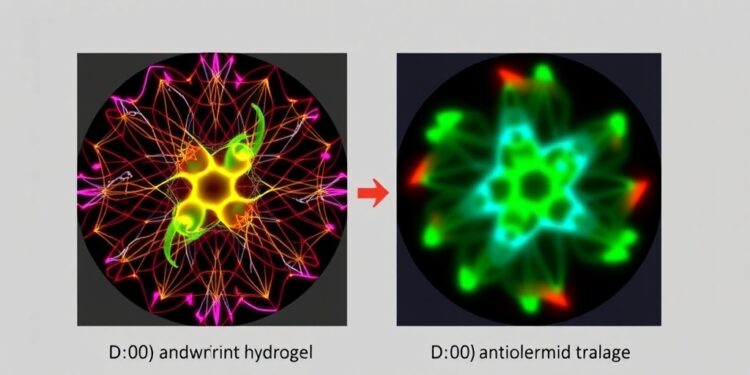Researchers exploring the potential of nature-inspired designs have taken a significant leap forward with the development of Bouligand-structured materials. Drawing inspiration from the Bouligand structure, a natural design found in certain biological materials, scientists have been diligently working to create innovative materials that can withstand impact while remaining flexible. This exciting research holds promise for advancing applications across a variety of fields, including impact-resistant bioplastics, ceramic armor, and biomimetic alloy composites.
Despite notable advancements in material science, many existing products still rely on single-scale brittle units. This reliance on singular structures often limits the functionality of materials, especially in applications requiring both strength and flexibility. The fundamental challenge remains that enhancing plasticity while maintaining structural integrity leads to a trade-off between ductility and toughness. Researchers believe that by integrating hierarchical active interfaces and autonomous response capabilities, they can overcome these limitations.
As a means to address traditional material trade-offs, researchers are focusing their efforts on the design of sophisticated Bouligand-structured materials featuring multi-level active interfaces. The goal is to create materials that dynamically respond to environmental changes, ultimately resulting in enhanced toughness and pliability. This endeavor aims to reshape how we approach the development of biomimetic materials, pushing boundaries that were previously thought insurmountable.
In a groundbreaking study published in the journal Materials Today, a dedicated research team, conducted by Professor QING Guangyan at the Dalian Institute of Chemical Physics (DICP) under the Chinese Academy of Sciences, embarked on an ambitious design and fabrication project. The team engineered a highly robust cellulose photonic hydrogel, integrating reconfigurability and mechanochromism into its architecture.
Utilizing the unique self-assembly properties of cellulose nanocrystals (CNCs), the researchers devised an innovative strategy to fabricate Bouligand structures. This approach provided precise control over the alignment of the network matrix through techniques like nanofiber sliding paired with hydrogen bond reconstruction. These actions were primarily activated through the interactions of water-induced hydrogen bonding, showcasing an elegant method of material manipulation at the nanoscale.
The photonic hydrogels produced in this study exhibited extraordinary mechanical properties, including a fivefold increase in toughness and stretchability surpassing 950% when compared to earlier hydrogel versions. This remarkable enhancement reflects not only an engineering triumph but also the potential for practical applications in industries requiring materials that can endure extreme conditions. The team’s innovative hydrogels also displayed an impressive color-changing property, oscillating reversibly between red and blue hues while retaining stable electromechanical sensitivity through repeated mechanical stress.
In terms of reusability, the hydrogels prove exceptionally durable, allowing for an effortless restoration of functionality with just a five-minute soak in water. This level of efficiency is significant, particularly when considering applications in sustainable bioplastics, flexible electronic substrates, and smart photonic devices, which increasingly demand not just performance but also ease of maintenance.
Professor QING expressed enthusiasm regarding the implications of this research: “This work provides a new way for the practical application of CNCs, paving the way for new sustainable materials in areas that demand adaptive and responsive properties.” The implications extend to sectors concerned with environmental sustainability, performance optimization, and the functionality of next-generation materials.
This study stands as a testament to the incredible potential that lies within the intersection of nature-inspired designs and advanced materials research. By learning from biological structures and processes, researchers not only expand our current understanding but also open doors to practical applications that were once deemed purely theoretical.
With industries from healthcare to engineering constantly on the lookout for versatile materials that can adapt to varying environments and stresses, bouligand-structured materials are positioned to be at the forefront of innovation. The adaptability and durability showcased in this research underscore the relevance of the outcomes, potentially revolutionizing product design across multiple sectors.
In the coming years, as technology continues to evolve, research like that conducted by Prof. QING’s team will play a crucial role in determining how we utilize materials in our daily lives. The ongoing development of these advanced materials will not only impact industries but also influence the way we think about sustainability in materials science, setting a new standard for future research and application.
In summary, the exploration of Bouligand-structured materials has significant implications for the field of materials science. By leveraging the principles of nature—specifically the unique characteristics of cellulose nanocrystals—researchers are developing versatile and durable materials that offer promising solutions to longstanding challenges. As advancements continue, the future of bioplastics, ceramics, and smart devices looks increasingly bright.
As the scientific community moves forward into this new era of material development, the collaboration between various disciplines will be imperative. This work exemplifies how interdisciplinary approaches can yield groundbreaking results, ultimately leading to the creation of materials that are not only innovative but also sustainable. The future has arrived, offering a glimpse into a world where advanced materials mimic the intricate designs of nature, ultimately benefiting society as a whole.
Subject of Research: Bouligand-structured materials
Article Title: Highly robust cellulose photonic hydrogels with reconfigurability and mechanochromism
News Publication Date: 30-Jan-2025
Web References: 10.1016/j.mattod.2025.01.008
References: Materials Today
Image Credits: Not applicable
Keywords
Photonics, Hydrogels, Composite materials, Biomimetics
Tags: advanced material science researchautonomous response capabilitiesbiomimetic alloy compositesBouligand-structured materialsflexible impact-resistant materialshierarchical active interfacesimpact-resistant bioplasticsinnovative material designnature-inspired materialsphotonic hydrogelsreconfigurable mechanochromic structurestrade-off between ductility and toughness





